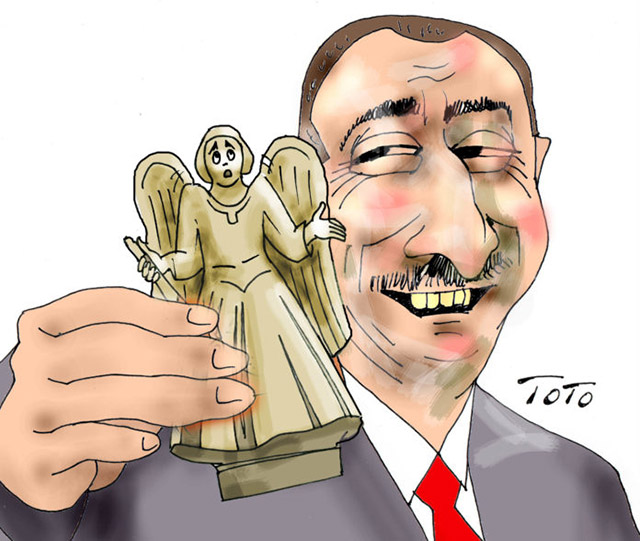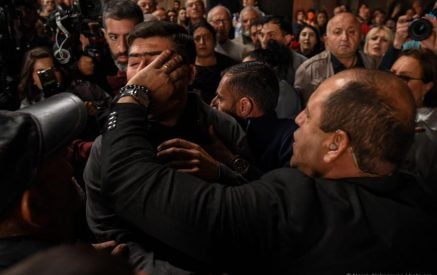by Edmond Y. Azadian
The Armenian Mirror-Spectator
During the Soviet period, Azerbaijan was the butt of many jokes. Such jokes were produced supposedly by the “Armenian Radio.” One such joke goes like this: A citizen calls the Armenian Radio to ask why Armenia does not have a Ministry of the Navy. The answer: because we don’t have access to the sea. Then the questioner asks, “Then why does Azerbaijan have a Ministry of Culture?”
It is not a racist statement to say that the Turks have been historically notorious for destroying other cultures. They destroyed the very sophisticated Byzantine culture after they conquered Constantinople and on their way to Istanbul from Central Asian highlands, they destroyed Armenian, Georgian and Hittite culture in Anatolia and elsewhere.
Read also
That destructive plan has been most active — if not intensified — after the eradication of the native Armenian people from its habitat in historic Armenia. More than 2,000 churches, monasteries, chapels and other monuments created by Armenians have been victims of the path of destruction of successive Turkish governments.
The Turks had even threatened to blow up Hagia Sophia Church, the Byzantine Orthodox Church, built in 537 AD, during the rule of Emperor Justinian, but settled on converting it into a mosque.
Azerbaijan boasts of being a Turkic nation and thus it has adopted the penchant for destroying other nations’ cultural symbols.
In 2005, the Azerbaijani army destroyed thousands of unique khachkars (cross stones) in the Julfa Cemetery of Nakhichevan, now an exclave under that nation’s rule, an act that was met with utter silence from the civilized world. Armenia’s voice and protests did not reach the proper authorities and the United Nations Education, Scientific and Cultural Organization (UNESCO), tasked with the mission of preserving the world heritage, did not lift a finger. In fact, Mehriban Aliyeva, the wife of President Aliyev, and currently the vice president of her country, was named a Goodwill Ambassador by UNESCO in 2004, a position she still holds.
During the 44-day war, Azerbaijan conquered the seven regions under Armenian control plus 75 percent of Karabakh (Artsakh). President Ilham Aliyev believes that he has settled the Karabakh conflict by force, which is contrary to the principals of the Organization for Security and Cooperation in Europe (OSCE) Minsk Group, tasked with arriving at a permanent peace, and the world powers think otherwise.
The co-chairs of the Minsk Group — Russia, France and the US — maintain that the issue of the status of Karabakh has not been settled and further negotiations must take place. Azerbaijanis have been dragging their feet and hampering any visit by OSCE representatives to Karabakh.
Besides the Minsk Group co-chairs, some interesting initiatives have been undertaken by the United Kingdom, which has heavily invested in Azerbaijan’s energy sector.
First, a bill recognizing the Armenian Genocide is on the agenda of the British Parliament, and now Britain’s Ambassador to Yerevan John Gallagher has expressed the official position of his government, in an interview with Armenpress, which coincides with the position of the OSCE Minsk Group co-chairs – that the Karabakh issue has not been settled and a solution needs to be finalized.
In the meantime, President Aliyev is in a race against time to erase all traces of Armenian culture in the occupied territories. While the rest of his country is neglected completely, Azerbaijan’s leader demonstrates an inordinate zeal to rebuild the territories recently captured from the Armenian forces.
Official sources in Stepanakert inform us that 1,456 Armenian architectural monuments face destruction or defacement in the territories recently occupied.
Azerbaijan’s government has vowed to erase Armenian inscriptions on Armenian religious sites in the territory reclaimed in the 2020 war. A video disseminated this week on social media shows that Azerbaijan has removed the cross from the Spitak Khach [White Cross] Church in the village of Vank, in Hadrut. In November 2021, the Azerbaijan government had organized a visit to this same church by the representatives of the clergy of the Udi community to declare that the church is part of the Albano-Udi heritage. This is the sophistry the Aliyev administration uses to misidentify the monuments of Armenian heritage. Despite the fact that many leaders of minorities, including the Udis, suffer in Azerbaijani prisons, in this case, they have become handy tools to usurp the Armenian monuments.
In March 2021, President Aliyev took a trip to Hadrut, accompanied by his wife and daughter. During that trip, dressed in military fatigues, he visited the 12th-century Armenian Holy Mother of God Church and said, “The Armenians wanted to Armenianize this church and wrote inscriptions in Armenian here. But they failed … All these inscriptions are fake. They were written later.”
Although Mr. Aliyev does not have any claim to fame as an archeologist, he knows better than all archeologists. He has assigned a committee of so-called experts to prove what he already knows. This is the Soviet style of scientific research; in Soviet times, Stalin used to concoct a theory and the experts in respective areas had to “prove” it scientifically. That is how they drained huge lakes, reversed the flow of rivers and rendered barren fertile farmlands.
President Aliyev cannot claim either to be the author of the theory that all the vestiges of Armenian heritage in the Caucasus belong to the Caucasian Albanians, who were supposedly the ancestors of the Azerbaijani people. That fake theory was promoted by a historian called Ziya Bunyadov in the 1950s. But he was successfully challenged by Armenian scholars in Soviet media and academic circles and it led to Bunyadov’s ridicule in scholarly circles.
Up until the creation of the so-called Republic of Azerbaijan, its population was known as the Tartars of the Caucasus, a people who had never achieved statehood of their own.
Very much like Turkey, which has developed a utilitarian narrative of its history to fit its current ideology, Azerbaijan has also resorted to the tactic to claim ownership of the territory that has belonged to other ethnic groups.
President Aliyev had promised President Putin to protect Christian sites now under its power, and UNESCO had urged Armenia and Azerbaijan to refrain from damaging cultural property belong to any people whatsoever, because cultural heritage belongs to all mankind. However, attempts by UNESCO to dispatch a mission to Karabakh to inspect the cultural heritage sites have been stalled. Even worse, UNESCO is not making a fuss about this very clear obstruction.
In addition to all the above promises and warnings, the International Court of Justice (ICJ) has ordered that Azerbaijan must “take all the necessary measures to prevent and punish acts of vandalism and desecration affecting Armenian cultural heritage, including but not limited to churches and other places of worship, monuments, landmarks cemeteries and artifacts.”
President Aliyev has ignored all commitments and warnings and in a challenge to the world community, he has assigned a committee to carry on his determination to deface and desecrate Armenian heritage. He has launched his war against Armenian history.
Azerbaijan’s Minister of Culture Anar Karimov told the press that a working group has been established which will be responsible for removing “the fictitious traces written by Armenians on Albanian religious temples.”
Endorsing Minister Karimov’s action, a Turkish-Islamic researcher, Telman Nusratoghlu has concurred that monasteries and temples in Azerbaijan’s Karabakh region are the historical heritage of Caucasian Albania.
“Everybody should know,” adds the scholar, “that Agoglan Monastery in the Lachin region, Khudavang [Dadivank] Complex in the Kelbajar region and Holy Elysee Temple Complex in the Aghdara region and Ganjasar [Gandzasar] Monastery there are the historical heritage of Caucasian Albania.”
Neither the European Union nor President Putin, who supposedly had taken Dadivank under his personal protection, have reacted to Mr. Aliyev’s challenge.
On the contrary, there is a move to appease Azerbaijan. Indeed, after the war, the European Union had pledged to support Armenia financially to the tune of 2.6 billion euros, but less than two hundred million euros for Azerbaijan. Azerbaijan had protested this disparity vehemently. Now, the European Union has decided to make a total of 2 billion euros in investments in that country, in addition to signing energy contracts.
This is the irony of realpolitik — no official reaction to Azerbaijan’s determination to erase all vestiges of Armenian history in occupied lands. There is only a lone voice, if that could be enough consolation. An influential newspaper in Europe has taken a strong position, based on moral grounds, in defying the Azerbaijani sacrilege. That is the newspaper Le Figaro in France. Indeed, the deputy editor-in-chief of the newspaper, Jean-Christophe Buisson, has criticized Europeans for diving into close cooperation with Baku in the energy sector amid that country’s cultural genocide against Armenian heritage in Artsakh. In a recent commentary, he stressed that Azerbaijan continues work to that end on Armenian heritage in Artsakh, but there is no reaction to it, neither from the French government nor UNESCO, and the EU welcomes the energy partnership with Baku. He further adds, “It is disgusting to see the European Commission strengthening relations with the Azerbaijani autocrat Aliyev, whose actions are aimed at destroying Armenians, their history, their churches, their heritage in Artsakh/Nagorno Karabakh. What a shame. … It is disgusting.”
Will there be any official follow-up to this courageous stand or will Mr. Buisson’s voice remain a sole protest in an echo chamber?
Time is of the essence as Mr. Aliyev’s war against Armenian heritage is roaring along.


























































